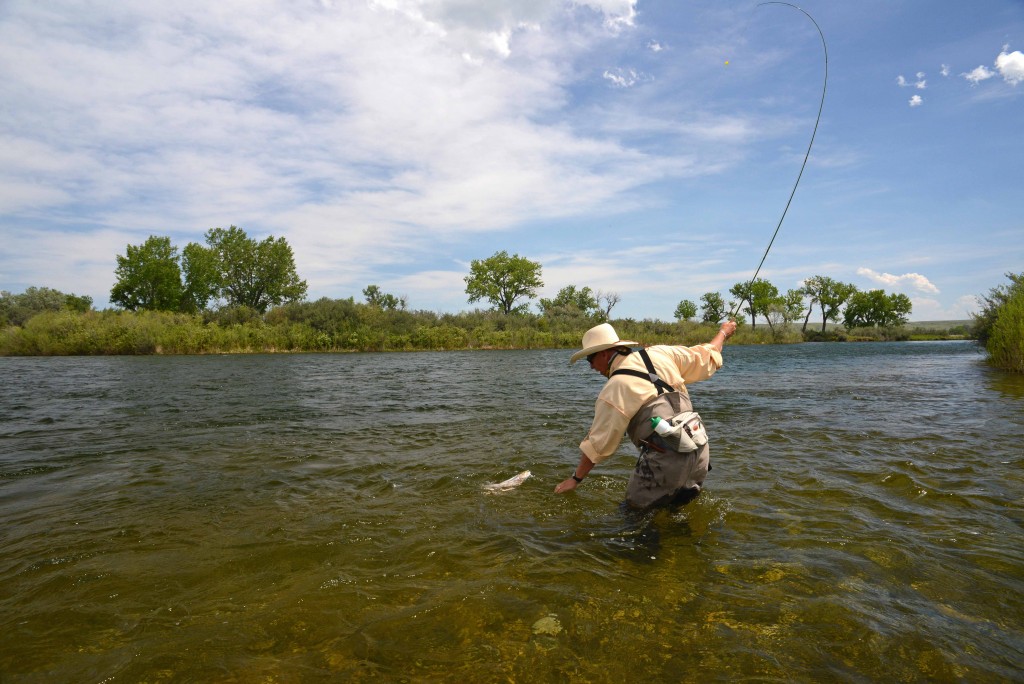Bighorn River Update 06.01.2014 … and Musings on Tippet
The river is rocking and rolling on dry flies. There is some epic surface action out there when the wind cooperates. Mostly midges with some Baetis mixed in. Expect the Baetis to ramp up this next week. The weather forecast is calling for partly cloudy or thunderstorms for the next ten days.
My dependable dry fly rig is still a larger, dark-winged CDC Sparkle Dun—larger as in #18—with a #18 or #20 Student on the end. Picky fish prefer the Student, and will eat it as a Baetis stillborn or midge. If the fish are in a feeding frenzy, they often eat the bigger Sparkle Dun. Grease the flies with Loon Lochsa initially, then powder with Frog’s Fanny thereafter. Some of our other guides are using a #18 TS Snowshoe PMD as their visibility fly, with a TS CDC Baetis on the point. The fish eat the big fly from time to time—not sure why. Just go with it.
There are some situations where the fish are selective. Don’t just assume because you hammered the fish one day on the user-friendly rig (dry flies you can see) that you will be successful the next day. Sometimes a huge midge emergence occurs and there’s a ton of pupa in the water. Since fish are concentrating on pupa lower in the water column or just below the surface, they may be reluctant to take dry flies. Anglers often lament the fact that their “secret spot” wasn’t very good the next day. Heavy pupa emergences can make you look bad, even if you have the right fly. There’s simply too much competition from Mother Nature. When this happens to us fishing guides, we try to explain to our clients, usually in a semi-scientific way, why they’re not catching fish, but they just shake their heads and give us disgusted looks.
Fluoro vs. Mono
When the fishing gets tough, people start looking for an edge. Sometimes the “fluorocarbon verses nylon mono” tippet issue revs back up. Which one should you be using for the ultimate presentation? As a fly shop owner and inveterate capitalist, I’d recommend the one that costs the most, preferably RIO Fluoroflex Plus in the 100 meter Guide Spool. It retails for $39.95. If this is a little steep, try the 50 meter TroutHunter fluoro for $22.95. Financing is available. But seriously, there are a few advantages to fluoro. It is reportedly less visible to the fish and it sinks a little faster. Even though there is a lot of hype about these two characteristics, I feel these advantages are negligible. Yes, it has a higher specific gravity than nylon, so yes, it will sink a tiny bit faster, but not enough to make much difference. And yes, it is slightly less visible to fish, but this “advantage” is miniscule considering the real reasons for angling success: presentation and pattern selection, with an emphasis on presentation. But fluorocarbon does have some advantages to carefully consider. It is more abrasion resistant. This is an especially big deal for saltwater anglers, but it can pay dividends in freshwater as well. And if you get a wind knot in fluorocarbon, it barely affects your line strength. It simply won’t cut itself like nylon. I like this when I’m guiding, as I don’t have to change out tippet as often. And fluoro isn’t affected by ultraviolet radiation. The big issue isn’t the breaking strength listed on the spool, the big issue is the breaking strength a week after you buy the tippet. Nylon deteriorates quite rapidly in sunlight and hot temperatures. Also, nylon absorbs water, up to 10% of its weight actually. When nylon absorbs water it stretches more and loses up to 20% of its break strength.
Another characteristic to consider is the environmental concern about fluorocarbon tippet. For all practical purposes, fluorocarbon never biodegrades. This is not good. However, were you aware that nylon monofilament takes 600 years to biodegrade. So the bottom line is be very careful when dispose of tippet. Don’t toss it on the ground or in the river. Cut it up into very small pieces when you can. I’m sure you’re aware of the countless shorebirds, eagles, turtles, and many other creatures that become entangled in discarded monofilament line.
